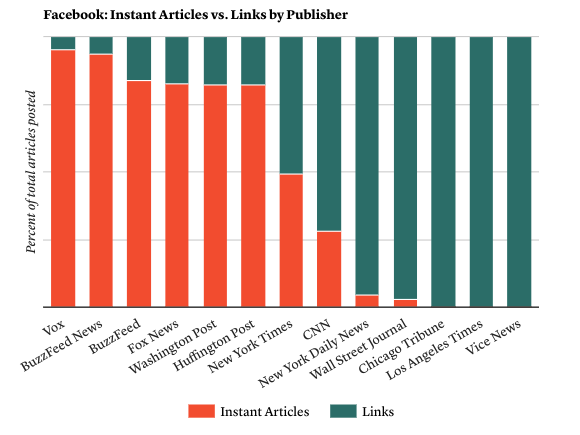News organizations may differ in how much they’re investing in platform-native publishing, but few if any are pulling out entirely.
During election week (November 7–13, 2016), the Tow Center for Digital Journalism followed the platform publishing activity of 15 big publishers and found that the organizations overall generated 12,120 posts on platforms. While there wasn’t a single narrative linking all the efforts, Tow did notice a few trends in platform publishing activity overall.
— Instant Articles is still popular, though few organizations are going all-in. Vox, The Washington Post, and The Huffington Post are all posting upwards of 80 percent of their content on Instant Articles, while The Wall Street Journal posts less than five percent (and others like Vice and the Chicago Tribune aren’t using it at all).
 — One winner is Instagram, which has become a popular publishing platform for news organizations not just with its regular image and video posts but also with the Snapchat-inspired Instagram Stories. The news organizations that Tow followed uploaded 253 Instagram Stories during election week.
— One winner is Instagram, which has become a popular publishing platform for news organizations not just with its regular image and video posts but also with the Snapchat-inspired Instagram Stories. The news organizations that Tow followed uploaded 253 Instagram Stories during election week.
— YouTube, on the other hand, seems to be losing ground, as more publishers look to Facebook as the preferred home for their short videos.
— Tow also found that metro publishers like the Chicago Tribune and L.A. Times were consistently less likely to embrace native content on Facebook, a trend Tow attributes to a combination of business and cultural factors. Another possibility: Facebook still has work to do when it comes to reaching out to regional and local publishers. As research fellow Pete Brown writes:
This pattern may be symptomatic of a broader problem many local publishers have had with gaining access to, and building relationships with, platform representatives. Representatives of local and regional publications have frequently complained in interviews of having less access to, or access to lower-ranking, partnership managers at platform companies. Indeed, neglecting the needs of local publishers in particular is a problem that Facebook has acknowledged publicly.
— Subscription-based publishers were less hesitant to invest in Apple News, which last September started to let publishers integrate their Apple News content with their existing paywalls. That was enough to win over the Chicago Tribune, which posted 1,280 articles on Apple News during election week, a 1,810 percent increase from Tow’s data collection period in August.
